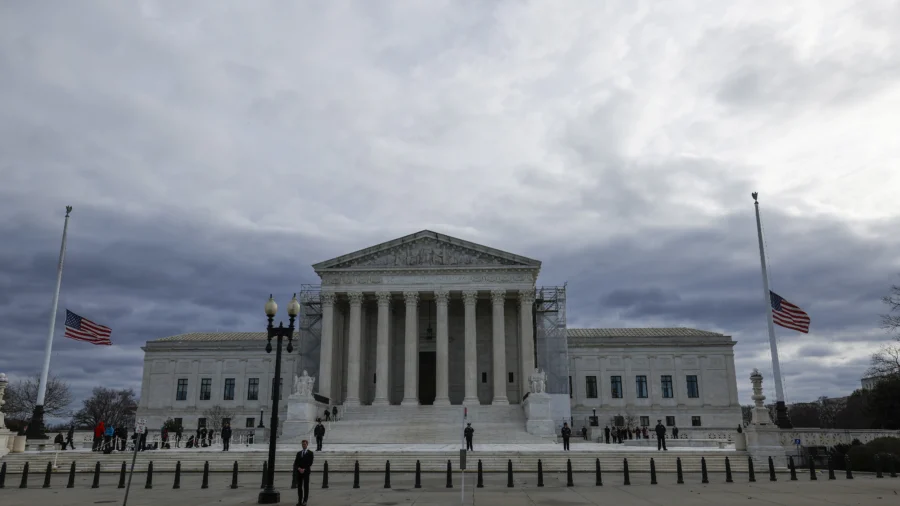The Supreme Court issued two orders that may allow the borders of a disputed state legislative district in Washington state to be finalized before elections later this year.
The political territory in dispute is Legislative District 15 in the central part of Washington. The district is currently represented by state Sen. Nikki Torres, state Rep. Bruce Chandler, and state Rep. Bryan Sandlin, all Republicans. A state redistricting commission redrew the electoral map, but the lower courts struck it down for violating the federal Voting Rights Act (VRA).
Democrats control both chambers of the state legislature. The Senate has 29 Democrats and 20 Republicans; the House, 58 Democrats and 40 Republicans.
On Feb. 20, the Supreme Court denied (pdf) the petition for certiorari, or review, in Trevino v. Palmer. Lead petitioner Jose Trevino is a registered voter. A co-respondent is Alex Ybarra, a Republican who represents the 13th district in the Washington House of Representatives. Lead respondent Susan Soto Palmer is a registered voter.
At the same time, it vacated a judgment in Garcia v. Hobbs, sending the case back to federal district court.
In Garcia v. Hobbs, the court issued an unsigned order that summarily voided the judgment of the U.S. District Court for the Western District of Washington “with instructions to enter a fresh judgment from which an appeal may be taken to the United States Court of Appeals for the Ninth Circuit.”
Lawyers call this process GVR, which stands for grant, vacate, and remand.
Benancio Garcia III is the lead appellant. Mr. Garcia was an unsuccessful candidate for the U.S. House of Representatives in the fourth congressional district of Washington in 2022. The lead respondent is Steve Hobbs, a Democrat who is Washington’s secretary of state.
The Supreme Court’s rulings came after the U.S. Court of Appeals for the 9th Circuit turned away a request to delay proceedings in the Palmer lawsuit pending the outcome of the Garcia litigation.
The new rulings allow proceedings to move forward in the U.S. District Court for the Western District of Washington. On March 8, the court will conduct an evidentiary hearing over the electoral district’s boundaries.
In the Palmer case in August 2023 a federal district judge struck down the legislative map for violating Section 2 of the VRA.
Section 2 of the VRA prohibits voting practices or procedures that discriminate on the basis of race, color, or membership in a large language minority group. Last year, Alabama had asked the Supreme Court to weaken Section 2. The court declined to do so, ruling 5–4 in Allen v. Milligan that the state’s electoral map for congressional elections was racially discriminatory and violated the VRA.
Plaintiffs argued in Palmer that state legislative districts redrawn following the 2020 U.S. Census deliberately diluted the voting strength of Latino voters.
The case went to trial in June 2023 and was heard alongside the similar Garcia lawsuit.
In his decision on Palmer, U.S. District Judge Robert Lasnik, who was appointed by President Bill Clinton in 1998, wrote that the question in this case “is whether the state has engaged in line-drawing which, in combination with the social and historical conditions in the Yakima Valley region, impairs the ability of Latino voters in that area to elect their candidate of choice on an equal basis with other voters.”
“The answer is yes,” Judge Lasnik concluded.
The court found “that the boundaries of LD 15, in combination with the social, economic, and historical conditions in the Yakima Valley region, results in an inequality in the electoral opportunities enjoyed by white and Latino voters in the area.”
After that decision was issued, a three-judge panel of the same U.S. district court dismissed the Garcia lawsuit as moot because the illegal racial gerrymander issue had already been dealt with in Palmer, the September 2023 opinion stated.
The Supreme Court’s decision means the district court that dismissed the Garcia lawsuit will have to rehear the case.
But the Supreme Court did not direct or encourage the district court to make any ruling in particular, which is unusual. Generally, when the nation’s highest court remands a case to a lower court, it includes specific instructions, such as to render a judgment consistent with a preexisting court decision.
In Garcia, the district court may choose to adopt the reasoning in Palmer and find an unlawful racial gerrymander, or it may opt not to do so. Whatever it decides, the losing party will be free to appeal the decision to the 9th Circuit, according to the Supreme Court’s Feb. 20 order in Garcia.
The Epoch Times reached out for comment to parties in both proceedings.
Noah Purcell of Washington’s Office of the Attorney General in Olympia, Washington, and Ms. Palmer’s attorney, Mark Gaber of the Campaign Legal Center in Washington, D.C., had not replied as of press time.
Jason Torchinsky of Holtzman, Vogel, Baran, Torchinsky, and Josefiak of Haymarket, Virginia, who represents Mr. Trevino and Mr. Garcia, also had not responded at the time of publication.
From The Epoch Times


